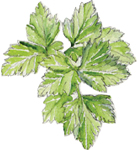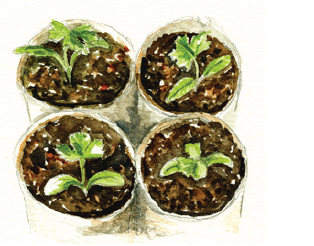

Now is the time for preparation
Start collecting small mustard-and-cress-sized plastic supermarket containers (measuring about 6 x 4 x 2in/15 x 10 x 5cm), preferably transparent ones, because lengthening roots are interesting to watch. Larger containers – those in which the concrete-like supermarket peaches are sold – can also be useful for more vigorous seeds and beans. Also collect the cardboard cores of toilet rolls. These make good cylinders for runner bean germination.
Buy some organic peat-free, seed-sowing compost. As you will be not only admiring the results of your sowing but eating them too, buy organic compost unless you find the idea of garnishing your food with sprinklings of artificial fertilizers appealing. Only a little is needed, so begin with the best.
Organic
The Oxford English Dictionary definition: ‘Of, relating to, or derived from living matter. A fertilizer or manure produced from natural substances, usually without the addition of chemicals.’
One knows these words as acquaintances; the definitions just deepen the acquaintance.
Buy a small sieve for sifting soil; also some plastic plant labels and a soft lead pencil. Invest in the smallest electric propagator. Alternatively, if you’re uncertain whether you’re going to enjoy window-box gardening, buy a full-sized seed tray with a transparent plastic lid, or a roll of cling film. To prevent the spread of disease, everything should first be washed in a mild solution of household bleach or sterilizing solution and then thoroughly rinsed. This is pleasurable winter-hibernation work, one’s hands in warm, soapy water. It makes January a friendlier month and brings spring forward. All that is needed now is time to study the seed catalogues.
Fear of sowing
It is astonishing how many grown-up people have never sown a single seed. The idea of seed sowing seems to fill them with trepidation, as though it is some magical process (which, of course, it is) only for the cognoscenti, and from which they are excluded. In fact seed sowing is one of the simplest things to do. If birds and breezes can do it, it should not be beyond humans, and 75 per cent of the work is done by the seeds themselves.
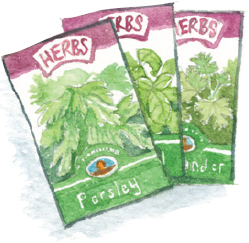
Trial parsley-seed sowing
For those who have never done any sowing, January is a good time to practise, before the real seed-sowing months arrive. Despite the saying that parsley should be sown when naked by moonlight, it can also be sown successfully indoors, when you are fully clothed and during daylight. It is one of the few plants that can be germinated indoors all the year round.
It is not necessary to have a potting shed, greenhouse or anywhere special to sow seeds. All that is needed is a table spread with newspaper.
The following basic instructions apply to sowing most of the seeds mentioned in this book.
1. Make drainage holes in the bottom of one of the plastic supermarket containers (some are already pierced), piercing them from the inside out to make certain the drainage works.
2. Crumble any lumps in the compost, then sieve it into the container until it overflows. The compost needs to be fine and friable (easily crumbled) to create a comfortable bed for the seeds and their roots to grow in – imagine yourself living in the compost. For those who are fond of their hands and don’t like the idea of touching compost, rub them with barrier cream before resorting to gloves; this at least lets the hands feel what they are touching, whereas gloves do not, a large proportion of the pleasure being on the other side of the glove – one might as well wear gloves while making love.
3. Give the container a firm shake. Level the surface of the compost with something straight, such as a ruler.
4. Gently press the compost down with your palm. Seeds need something firmish, but not rock hard, to rest on.
5. Put the filled container into the sink, then fill the sink with water until it comes halfway up the container’s sides. Leave until the compost has drunk its fill and glistens on top like coal. Remove and allow to drain. Watering before sowing avoids disturbing the seeds and makes their sowing simpler, as they are more visible against the water-darkened compost. It also makes it easier to see how much soil to sieve on top. (Another advantage of pot and window-box gardening is that a single packet of seeds can last for several years. Parsley seeds given to me five years ago are still germinating. Seeds of an Arctic lupin have been known to grow after lying in the ground for 10,000 years.)
6. A 6 x 4 x 2in (15 x 10 x 5cm) container will take only about fifteen nasturtium-sized seeds, or fewer. Some seeds, such as Virginia stock (a few flowers have been included for the sake of their scent or colour), prefer to be sown on the surface of the compost and left uncovered. Others need more privacy and require a light covering of soil. The seed packet instructions usually indicate the seeds’ needs.
7. Italian plain-leaved parsley seeds are greyish and rowing boat shaped. Mark out five evenly spaced rows of three seeds each by making shallow fingertip indentations in the compost. Place a seed in each hollow. Sieve 1/8 in (3mm) of soil over the surface, until the damp compost below disappears. Gently firm the surface with your palm – just a reassuring pat, the sort you would give to a nervous cat. Remember the shoots have to push their way up through the surface, so don’t want too much of a struggle.
8. Write the date, name and number of seeds sown on a label, stick this into the edge of the container.
9. Cover the container with a plastic lid or some cling film, or put it into the electric propagator. When using a propagator, first spray its base (on which a little compost or sand has been laid) with water, as this helps to create a Turkish bath-like atmosphere. Place on a semi-sunny bedroom windowsill where it will be checked at least twice a day and won’t suffer from neglect.
10. After a short time the walls and ceiling of the propagator or container cover will start to warm and pour with sweat. The tiny glow-worm light of a propagator-incubator switches itself on and off. Whether it is wishful thinking or just imagination, the bedroom feels different. There is a sense (particularly during the night) of something else being in the room other than a human being. Even though the seeds are only minuscule in size, they are alive. You are not alone.
Types of parsley
The world of parsley is more mysterious than one might think. I am advised by an expert that flat-leaved parsley (Petroselinum crispum var. neapolitanum) includes French, Italian and Neapolitan sorts such as ‘Gigante di Napoli’ (commonly known as ‘Italian Giant’. There are also moss-curled sorts (Petroselinum crispum) such as ‘Champion’ and ‘Rina’, and Hamburg (root) parsley. Japanese parsley (mitsuba, Cryptotaenia) is closely related. All have a different taste, appearance, colour and texture. Why not become a parsley specialist?
Or, if you don’t like parsley or are anxious about sowing seeds, you could, if you have a cat, grow a portable cat-grass ‘lawn’. These can be found (pre-sown) in boxes in pet shops and some supermarkets. Just add water. Each morning, my cat rushes like a health fanatic to her portable lawn and, head tilted sideways, chews down the stems, enjoying a pre-breakfast salad.
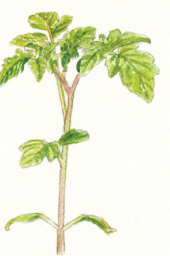
Go to the public library, children’s section, and look for a book on seeds to find out what is inside those grey rowing-boat-shaped parsley seeds. Children’s books are, on the whole, better illustrated than adults’ and, on subjects like this, easier to understand. Within the seed coat lies a minuscule seed (the ovule of a plant), inside which is a tiny new plant, consisting of a seed leaf, shoot and root (and a larder of food to live on).
Find out about wormeries, although it is still too cold to inaugurate one yet (see page 20).
Plan on starting a simple compost heap in a plastic sack or plastic dustbin (see page 39).
Look out for unusual vegetables in greengrocers and supermarkets. Go to Chinese, Caribbean, Turkish and Indian greengrocers and buy vegetables you have never seen before and whose names you don’t know. Choose those that have root-sprouting possibilities. Chinese single-clove garlic, lemongrass, sweet potatoes, Japanese artichokes: all these, and more, can be started off indoors in water or suspended just above it, the base touching but not submerged (or else it will rot). In the case of sweet potatoes, if one end doesn’t root, turn it upside down and try the other.
If possible, buy organic seeds (see page 170) to stop the spread of non-germinating, terminator-gene seeds. These are sterile seeds – unlike the fertile profits of some seed companies, which force us to buy more and more seeds instead of saving them. Terminator-gene seeds must be one of the most dire combinations of mammonism and immorality – something that one imagines could only take place in science fiction.
The days are getting lighter by a minute a day, or so says The Times. The lid of darkness is being raised, fractionally, and with it our expectation. The following is a sample from a seed-sowing diary I wrote last spring when growing tomatoes for the first time:
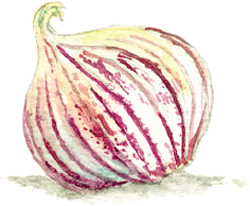
Day 1 A packet of tomato seeds: so light in weight there’s no castanet rattle when they are shaken. Yet these dust-sized specks (assisted by the four elements) contain potential stems, scent, leaves, pollen, colour, root and rootlets, taste, flesh, sap, flowers, texture, fruit, juice and yet more seeds for next year’s harvest: they contain the future – something that should never be taken for granted. An electric propagator: it is attached by a cord to a plug, has a greenhouse-like top with ventilation slides and fits on a bedroom windowsill. Compost: moist, warmish in its plastic sack and fine; I would be perfectly content to germinate in this comfortable-looking soil. Sift it through your fingers like making short-crust pastry. The seed tray is filled to the brim, levelled, then firmed down with a presser board, which resembles a wooden palm on the surface of the soil. A pinch of the fragile, fly-away seeds is scattered from above. If two or more seeds insist on lying together, coax them apart – a fingertip away from each other. Between the palms, a ‘rain’ of ¼ in (6mm) of compost is sifted, then gently pressed down. (Or sift it through the small plastic sieve.) Greenhouse cover is placed on top, ‘electric blanket’ switched on, propagator put on the windowsill and the curtain a quarter drawn to shade the tray from too much light. This compost bed has been made with more care than one makes one’s own. After sowing, the invisible seeds are left alone in their centrally heated indoor ‘greenhouse’. It is time to wait. Wake up in the night to see if tiny orange thermostat light is on. Wonder what is silently and mysteriously taking place in the soil – or perhaps not so silently if one could really hear: the sound of seed cases preparing to split open.
Day 2, a.m. Greenhouse top is misted and sweating. Peer through the misting to see if anything is happening. It isn’t – visibly.
Day 5, early morning Faint eruptions have appeared on the soil surface; they could have been made by tentative moles.
Day 5, later in the day Mole eruptions have become larger and are now miniature earthquakes, as the thin-as-hair stems push upwards, heads still buried.
Day 5, evening Heads are still buried, arched stems resembling croquet hoops on lawn.
Day 5, midnight Croquet hoops are no longer there. In only a few hours the heads have risen, breaking out of their seed coats, and are now upright, two-leaved. What force is needed, first, to create the upheavals in the compost and, second, to raise the fragile stems from horizontal to vertical?
Day 6, 6 a.m. Remove greenhouse top. Seedlings lean away from the room towards the window, leaves outstretched horizontally like a troupe of gymnasts.
Day 6, 9 p.m. Leaves raised upwards, folded together: gymnasts exercising.
Day 7, morning Turn tray round so that leaning-towards-the-light seedlings can straighten their stems.
Day 7, evening All stems are straight. After a few more windowsill days in the sun with the curtain protecting them at night from the open window’s air, it is time for them to go outside. First into a miniature outdoor ‘greenhouse’ (i.e. a large plastic cloche), but only for the choicest slice of the day – its middle. Then back they come in the late afternoon.
In and out they go each morning and evening. All of the seed packet’s promised contents have germinated. All thirty stems are now protected by the finest, fur-like hairs – vertical haloes when seen against the light. Only a few are late beginners, handicapped by seed cases that remain clamped to their two leaves, preventing them from opening. It is tempting to assist and release them, but more interesting to resist and see how the struggling leaves manage to free themselves.
It is time to do a little judicious thinning-out of seedlings that are growing too close together, endangering each other. Now’s the moment to test whether they already smell or taste of tomato. They don’t, neither stem nor leaves. But then the shape of the first two seed leaves gives no hint of what they are going to become – unlike basil at the same age. Long before basil seedlings are ‘large enough to handle’, they are imbued with the clove-ish spiciness of their future.
Day 11 Third leaf is preparing to appear. It is triple-, not single-lobed, even in infancy, and this is the first sign of the tomato plant it is going to become. Does this visual indication also hold the identifying smell and taste? No. Still it releases no scent or taste.
Day 12 Although the tomato plants are still too fragile to be watered from above, even with a fine rose spray, they are now sturdy enough to stand up for themselves against breezes, trembling only slightly without toppling over. Watering is done with the narrowest watering-can spout, dribbled on to the compost in which desert-like cracks appear.
Seed sowing must be one of the most absorbing of occupations. It is not only the actual doing of it, but also the anticipation, the anxieties and thoughts surrounding it … imagining what is going on inside the seed tray, as the white galaxy of fragile roots spreads through the dark earth.
Day 12, 10 p.m. Rush back early from a party to close the window and rescue the tomato plants from an unexpected drop in temperature.
Day 18 Pricking-out day – the move from tray to individual pots. Fill 3½in (9cm) pots with compost. Use both thumbs to make a hole in the centre – like making a clay pinch-pot – to receive the plant and its roots. Scoop out a heaped dessertspoonful of chocolate-coloured cake compost, in the centre of which is a small, giraffe-like creature with its long, furry-neck stem and white spider’s-web roots. Place in the hole.
One by one the pots line up. Glance down and notice that the first of the transplants is drooping; prop it up with a pea-size piece of compost. Only a few minutes later, in the time it took to make a cup of coffee, panic! Fifteen plants are drooping – sulking in unison. Race at ambulance speed to place the fifteen casualties ankle-deep in a trough of water.
Wait for the first signs of recovery and discover the compost bag’s planting instructions: the pots should have been watered before, not after, pricking out. It is touch and go. After what seems a long time, but is in fact short, for stems and leaves to rise from facing the earth to facing the sky, the panic is over.
First whole night in ‘greenhouse’.
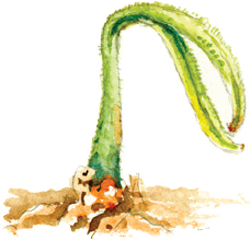
Day 19 Raise cloche to see how plants have fared in their pots. All are flourishing.
Day 22 Fifth leaf appearing. Plants are now stocky enough to be watered from above with a fine rose spray. Stems are thickening. Fur-like stem hairs stop at the two first leaves; then the fur thins out, becoming like fine barbed wire, to deter insects perhaps.
Day 25 Three-lobed leaves are now sufficiently resilient for raindrops to balance and perch on them without toppling them. When twenty-nine plants are flourishing with four or five leaves, the last of the late beginners’ first two leaves still remain clasped together, forcing the growing tip sideways; despite this stubbornness, the third and fourth leaves have managed to open. At last, by bending low over the tomato plants, it is possible to smell the peppery scent that they keep so close to themselves. Soon gangly adolescent stems will need cane supports. The rest of the tomato story is known.
Liked and disliked tomatoes
‘Gardener’s Delight’ tomatoes have such a specific taste and are so sweet, small and juicy they are more like fruits (their original definition) than vegetables. On the other hand, ‘Marmande’ tomatoes resemble sumo wrestlers (in size, approximately six ‘Gardener’s Delight’ equal one ‘Marmande’). They have an unappealing, half-asleep taste of pink water and an unpleasant soft texture which offers about as much resistance as damp cotton wool. When they are grown in their country of origin perhaps they are different.
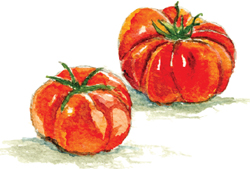
Purple potato harvest
5 January. From a 9in (23cm) deep x 8in (20cm) wide pot I am ‘digging’ up a harvest of new potatoes. The ‘digging’ is being done with my hands, which is far more enjoyable than using a trowel or fork. When my fingers are buried in the compost, they feel blindfolded as they sift their way through the soil, searching for solid shapes as though playing hide and seek. Is this how worms (which have no eyes) feel when travelling through the earth? It reminds me of being in one of those ‘black’ restaurants where one eats in pitch darkness.
The potatoes are much colder and darker than the soil in which they secretly live (stemless and leafless at this time of year), as though they have absorbed the earth’s blackness. They are Maori potatoes and have a mysterious shot-silk-like sheen similar to that of freshly mined coal. Oblong in shape, they resemble ‘Pink Fir Apple’, though they are not as rheumaticky.
After rinsing them (they hardly need washing and the sooner they are placed in boiling water or a steamer, the better) you will discover that the blackness is in fact a somber Lenten purple. When they are cut in two the purple lightens, though it is still purple – there is nothing lilacky about it; but the flesh is slightly marbled. If a potato is placed on your palm, it leaves a purple imprint and reveals, surprisingly, how sappy and juicy potatoes can be. When placed in a pot of bubbling water, the potatoes resemble hippos wallowing in a blue-green spa.
Unlike some purple or blackish potatoes, these retain their colour when cooked. Their texture is dense and the taste slightly chestnutty, not really in need of either salt or butter. It is the only purple food I have eaten, the colour giving it a rather serious taste. (One can now buy purple potatoes in England, but not Maori potatoes.)
These Maori potatoes lead a somewhat complicated life: Maori in name, South American in origin, papal purple in colour, and requiring to be planted on Good Friday. Obviously an Antipodean Easter is the opposite of our northern hemisphere variety: considering all this confusion, it is astonishing that they flourish at all, but they do.
These potatoes were planted in mid-April a year ago. Despite their complicated ancestry it did not take them all this time to decide to grow, so this was not their first harvest. I keep them in the soil instead of in a larder or refrigerator.
Apart from my roof garden, I have a very small shady garden in which almost nothing grows, willingly. It has been sown with wild flowers but instead of the poppy, cornflower and daisy tapestry I imagined, all that emerged were spindly weeds. Next came strawberries, wild and tame. Although they produced flowers, they obviously decided that that was enough. I then tried potatoes, assuming that as most of their growing is done underground in pitch darkness, they wouldn’t be too fussy about shade. Although they produced promising haulm bouquets, the crop consisted of a few marble-sized potatoes which, when cooked, were indistinguishable from pebbles. The final attempt was an asparagus bed. This involved waiting in anticipation for a year before the first spears appeared. When they, the two of them, did appear they were toothpick thin. The only plant which grows enthusiastically is minute, bright green and resembles bouclé knitting.
I then made a grandiose decision: I would relinquish the whole plot – as though it was at least Sissinghurst – and dedicate it to wildlife conservation. I studied catalogues: there would be a bat box, bumblebee nester, ladybird feeder, frog cabin, pond, nest boxes and a hedgehog bungalow. Hedgehog rescue centres, I had been informed, were in need of additional accommodation for elderly and disabled residents.
Before ordering, I did some research. The first disappointment was the bat box. Although I have seen bats scything through the air only feet away from my flat, apparently it faces in the wrong direction for their shelters. As I am not prepared to move, that was that. I ordered a ‘sparrow terrace’, what resembled a crotched ‘nest pocket’ for wrens, an ‘easy clean’ blue tit box and a tawny owl nest tube. Before ordering the frogs’ pond ramp, I discovered that ponds need sunshine to prevent them from stagnating. Also, as the garden is walled, it is unlikely that any homeless frog would leapfrog over the 7-ft/2m wall on the off chance that there might be a pond plus vacant accommodation on the other side. Although the ladybird chalet looks attractive, there probably would not be much to observe. The same applies to the solitary bee nester. This is a log drilled with masses of holes resembling one-room flats, presumably used for resting and nesting, so would hardly be a hive of activity.
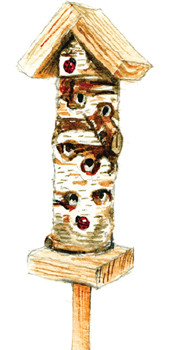
The most disappointing result of the research was that my desirable little garden proved to be unsuitable as a hedgehog sanctuary.
‘Hedgies’, I was informed, ‘need a lawn and a two-mile run when foraging for food.’
‘Even disabled or elderly hedgies?’ I enquired, feeling over-familiar using the diminutive.
‘Yes.’ (To create the illusion of space, some people buy treadmills for their hedgehogs, but I don’t care for the idea of any creature endlessly walking nowhere.)
‘What about visually impaired hedgehogs?’ I asked, careful to avoid the word ‘blind’. ‘And how’ – I felt slightly guilty persisting – ‘would they know? Wouldn’t they assume that the bouclé knitting was a lawn?’
‘Many hedgies are quite disorientated already.’ Was this a euphemism for Alzheimer’s? Apart from a bungalow, which has an internal corridor (nice enough to move into oneself), I imagined that their only other need would be the occasional saucer of milk.
‘When they’ve stopped hibernating, they need feeding.’ This meant that only during hibernation (the worst of the winter months) would I be able to go away.
The last possibility was a solar insect theatre. Its light switches on automatically at dusk, enticing lacewings, moths, butterflies and other thespians through its side panels, i.e. the stage equivalent of ‘wings’. Included was an insect ‘landing perch’.
Immediately it arrived I prepared the prescribed sugar/water attractant and waited in anticipation for dusk, as though waiting for a first night. Not even a clothes moth condescended to make a debut. After a few days the attractant evaporated. The next item on the menu was dark beer heated with molasses and brown sugar. Result: hardly a sell-out at either the matinée or evening performance. The third attractant was over-ripe banana mashed with rum. Result: the theatre remained empty, and I was left with a bunch of black bananas (something I particularly dislike) and almost full bottles of dark beer and brandy plus a tin of molasses – not the easiest of ingredients to amalgamate into one’s diet.
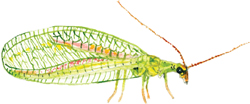
Four months later: not even a fly has landed on the insect perch. Apart from one short ‘let’, the nest boxes have remained vacant, making me feel like a failed estate agent.
 Seeds to sow now, indoors
Seeds to sow now, indoors
Italian flat-leaved parsley (Petroselinum crispum var. neapolitanum)
‘Gardener’s Delight’ tomatoes (Solanum lycopersicum) (January–March, says the packet)
Sweet peas (Lathyrus odoratus) (January–mid-May)

WHAT TO EAT NOW
Fried parsley: an alternative to croutons
Why did fried parsley become unfashionable, to be replaced by fried seaweed, which is generally not seaweed but cabbage?
2 large handfuls of parsley
corn oil (or other mild-flavoured oil)
Remove the lower, thicker stems from two large handfuls of what is now imaginatively called ‘bunched parsley’ (i.e. ‘Champion’ moss-curled parsley). Wash thoroughly. Drain and dry even more thoroughly. In a wok heat about half an inch of corn oil until very hot. When a test piece of parsley sizzles and rises to the top when placed in the oil, put the rest in. Fry until crisp and dark green. Remove with a slotted spoon and drain on several sheets of absorbent paper.
